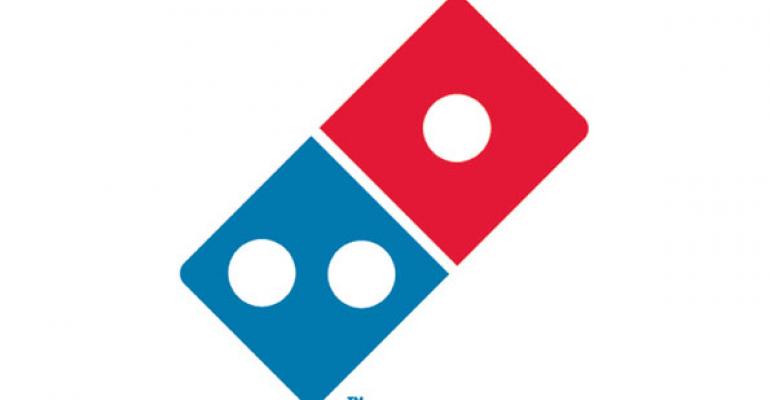Domino’s Pizza Inc. officials said on Thursday that domestic operators would further shift their marketing spending in 2013 to national programs, building on sales momentum from its advertising programs and product introductions of 2012.
Chief executive Patrick Doyle stressed to investors during the company’s fourth-quarter earnings call that the move was not an incremental increase in franchisees’ contributions to Domino’s marketing funds, but a reallocation from local couponing to mass media and digital.
“We’re simply seeing it as a better return on investment of those dollars,” he said. “What’s most important, frankly, is that our system had the confidence and the trust in what we’re doing and the results that we’ve been driving to make that commitment to us.”
RELATED
• Domino's Pizza introduces pan pizza
• Domino's Pizza: IT a key competitive advantage
• More restaurant industry finance news
Domino’s net income jumped 21.6 percent in the Dec. 30, 2012-ended fourth quarter to $37.6 million, or 64 cents per share, compared with $30.9 million, or 52 cents per share, a year earlier.
Fourth-quarter revenue rose 7.5 percent to $539.7 million, due to higher sales volume in its domestic supply chain, 183 net store openings in the international division, and same-store sales gains of 4.7 percent at domestic restaurants and 5.2 percent at international locations.
Full-year net income grew 6.7 percent to $112.4 million, or $1.91 per share, compared with $105.4 million, or $1.71 per share, a year earlier.
Full-year revenue rose 1.6 percent to $1.68 billion, compared with $1.65 billion in fiscal 2011. Same-store sales grew 3.1 percent in the United States and 5.2 percent in the international division for the year.
The Ann Arbor, Mich.-based company also said it would initiate a regularly scheduled recurring dividend, beginning with a 20-cent dividend to be paid March 29.
No flash in the pan
Doyle credited several factors for the strong fourth-quarter domestic results, including the chain’s continued advertising around value offers, sustained benefits from investments in online and mobile ordering, and the launch of Handmade Pan Pizza in early October.
The new pizza, which carried a $7.99 price point for a two-topping medium version — $2 more than the popular value offer on a medium, two-topping hand-tossed pizza — helped Domino’s end the year with positive traffic.
“We were strong enough on order counts in the second half of the year, particularly in the fourth quarter, where we finished with modestly positive order counts for the year,” Doyle said. “So the overall effect [of Pan Pizza’s launch] was great. We definitely drove more customers into the franchise … and it was a bit ahead of our expectations [on sales mix].”
The new item more likely prevented customers from leaving Domino’s to get a pan pizza at Pizza Hut or an independent restaurant than it attracted new customers, he speculated. “What we saw more was customers who already did business with Domino’s that would take their pan business elsewhere started giving us some of those occasions,” Doyle said.
Sales of pan pizzas, which typically involve more cheese and toppings than regular pizzas, also drove a substantial amount of business through Domino’s company-owned domestic commissaries, chief financial officer Mike Lawton added.
The brand of 4,928 U.S. restaurants will look to sustain positive trends by taking franchisees’ marketing contributions of 6 percent of revenues to national advertising in 2013. Prior to this year, operators’ requirement was to contribute 5.5 percent to national marketing, and most of them continued to pay an additional few percent to advertising co-ops for local-store marketing.
The last time Domino’s altered its marketing fund requirement was 2010, the first full year of its systemwide relaunch of its core pizza. Franchisees then went from required contributions of 4 percent to national marketing and 2 percent to local marketing to just one 5.5-percent contribution for national advertising.
“It’s all about mix,” Doyle said. “The return we’re seeing for activities directed nationally are better than the returns we were seeing from local activities, which are mostly about the print.”
The IT factor
Continued from page 1
Doyle also noted that investments in information technology continue to pay dividends for Domino’s. At an Investor Day presentation earlier this year, executives point out that the brands' scale in IT, especially for placing orders over the Internet and on smartphone apps, was a big competitive advantage that would help Domino’s take market share from independents and regional chains unable to make such investments.
The chain now receives more than one-third of its orders from digital platforms. That has produced favorable benefits on labor cost, but that was not always the case, Doyle said.
“It took some critical mass,” he said. “When we were at 10 percent to 15 percent [of sales for online ordering], we thought we were going to see labor efficiencies and we really weren’t. As we’ve gotten up to north of 35 percent of sales, we definitely see that now.”
He added, “There are a number of ways where it shows up over time,” including saving company-owned stores money on utilities, since more online ordering means fewer phone lines need to be maintained in each store.
Many stores still derive their sales from online ordering well below the systemwide average, leaving some moderate runway for more upside, he said.
“More savings will come,” Doyle said, “just not in the hundreds of basis points on the labor line.”
Domino’s operates 388 company-owned units and franchises another 4,540 in the United States and 5,327 restaurants internationally.
Contact Mark Brandau at [email protected].
Follow him on Twitter: @Mark_from_NRN

